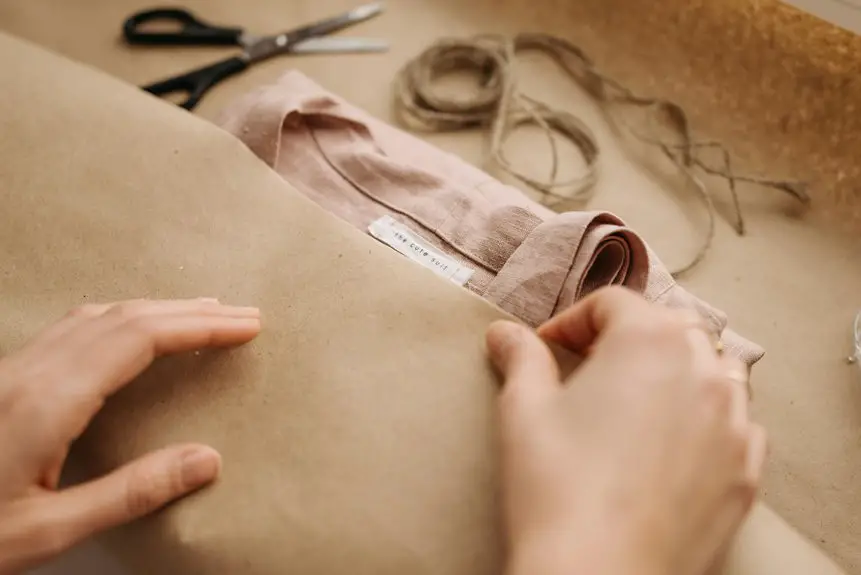If you want softness and breathability, polycotton’s blend of cotton and polyester feels gentler on your skin and lets air circulate better, keeping you cooler. Polyester alone feels slicker, dries faster, but isn’t as breathable. For care, polycotton wrinkles a bit more but stays comfortable with moderate ironing, while polyester resists wrinkles and lasts longer with low-heat care. Keep exploring to uncover which fabric suits your lifestyle best.
Table of Contents
Key Takeaways
- Polycotton feels softer and more natural against the skin due to cotton, while polyester has a slicker, synthetic texture.
- Polycotton offers better breathability and moisture absorption, keeping wearers cooler, whereas polyester dries faster but traps heat.
- Polyester is more durable and wrinkle-resistant, requiring less ironing compared to polycotton, which wrinkles moderately and needs medium heat ironing.
- Polycotton absorbs stains more easily and benefits from prompt blotting, while polyester repels water but can set stains if exposed to high heat.
- Polycotton typically costs more due to cotton content, offering comfort and versatility, whereas polyester is cheaper and provides long-term durability.
Composition and Fabric Structure of Polycotton and Polyester
Although both polycotton and polyester are popular fabrics, they differ considerably in composition and structure.
When you choose polyester, you’re selecting a fully synthetic fabric made from petroleum-based polymers. This means it’s fundamentally a plastic fiber with a smooth, tightly woven structure.
On the other hand, polycotton blends natural cotton fibers with polyester, typically in ratios like 65% cotton and 35% polyester. This blend combines cotton’s breathable, soft cellulose fibers with polyester’s strength and durability.
Polycotton blends breathable cotton with durable polyester, balancing softness and strength in one fabric.
You’ll notice that polycotton’s fabric structure is a hybrid, offering benefits from both fibers, while polyester’s structure remains uniform and synthetic.
Understanding these differences helps you pick the right fabric for your needs, especially when considering durability, breathability, and care requirements.
Comparing the Texture and Softness of Polycotton and Polyester
When you touch polycotton, you’ll immediately notice its softness, thanks to the cotton fibers woven into the blend. It feels smooth and gentle against your skin, often more comfortable than pure polyester.
Polyester, in contrast, has a synthetic texture that can feel slick or slightly rough, depending on the weave. While polyester tends to be less pliable, polycotton offers a balanced feel—combining cotton’s natural softness with polyester’s durability.
If you prioritize comfort, polycotton typically wins, as it reduces the sometimes plasticky sensation polyester carries. However, polyester fabrics can be engineered to feel softer with special finishes.
Breathability and Moisture Management in Both Fabrics
Breathability plays a crucial role in how comfortable a fabric feels during wear, especially in warm or active conditions. When you choose polycotton, you get a fabric that balances breathability and moisture management.
Thanks to the cotton content, it allows air to circulate better than pure polyester, helping you stay cooler and drier. Polycotton also absorbs moisture well, wicking sweat away from your skin, which makes it more comfortable for prolonged wear.
Cotton in polycotton enhances airflow and moisture absorption, keeping you cooler and more comfortable longer.
On the other hand, polyester is less breathable but dries faster because it repels water rather than absorbing it. If you’re active and need quick-drying gear, polyester works well.
However, it may trap heat and moisture close to your body, which can feel sticky. So, your choice depends on whether you prioritize airflow and absorption or quick drying.
Durability and Strength Differences Between Polycotton and Polyester
You’ll notice that polyester generally lasts longer and resists wear better than polycotton.
When it comes to tensile strength, polyester holds up stronger under tension, making it more durable for heavy use.
Understanding these differences helps you choose the right fabric for your needs.
Fabric Longevity Comparison
Comparing fabric longevity between polycotton and polyester reveals clear differences in durability and strength.
When you choose polyester, you’re opting for a fabric that resists wear and tear exceptionally well, making it ideal for items you want to last long without significant fading or fraying.
Polycotton, blending cotton and polyester, offers moderate durability but tends to show signs of aging sooner, especially with frequent washing.
You’ll notice polyester maintains its shape and color over time better than polycotton, which can pill or weaken depending on the cotton content.
If longevity is your priority, polyester stands out, but if you prefer some natural fiber benefits while still having decent lifespan, polycotton is a balanced choice.
Your care routine also impacts how long either fabric lasts.
Tensile Strength Variations
Although both polycotton and polyester offer strength, their tensile strength varies considerably due to their fiber compositions.
Polyester fibers are synthetic and engineered for high tensile strength, which means they can withstand more tension before breaking. When you choose polyester, you get a fabric that resists stretching and tearing better than polycotton.
Polycotton blends, combining cotton and polyester, offer moderate tensile strength. While the cotton component adds softness, it lowers overall durability compared to pure polyester. This means polycotton is more prone to wear and tear when subjected to heavy stress.
If your priority is long-lasting, strong fabric that holds up under strain, polyester is the better choice. But if you want a balance of comfort and reasonable durability, polycotton will serve you well.
How Each Fabric Reacts to Wrinkles and Creasing
You’ll notice that polyester resists wrinkles better than polycotton, which tends to crease more easily.
This means you might spend less time ironing polyester garments.
Let’s explore how these fabrics handle wrinkles and what that means for your clothing care.
Wrinkle Resistance Comparison
When you handle polycotton and polyester fabrics, you’ll notice they respond differently to wrinkles and creases. Polycotton blends resist wrinkles better than pure cotton but still show some creasing, while polyester is highly wrinkle-resistant, bouncing back with minimal effort. This difference affects how often you’ll need to iron or steam your clothes.
| Fabric | Wrinkle Resistance | Ease of Smoothing Wrinkles |
|---|---|---|
| Polycotton | Moderate | Requires light ironing |
| Polyester | High | Wrinkles fall out easily |
| Cotton | Low | Needs frequent ironing |
Crease Formation Tendency
Understanding how polycotton and polyester handle wrinkles leads naturally to examining their crease formation tendencies.
When you wear or store these fabrics, how they crease matters for appearance and comfort. Polycotton tends to crease more easily because of the cotton fibers, showing sharp lines after folding or sitting.
Polyester’s synthetic nature means it resists deep creases, often bouncing back quickly.
Consider these points about crease formation:
- Polycotton creases visibly, especially at bends and folds.
- Polyester resists creasing and recovers shape fast.
- Polycotton’s creases may stay longer without prompt smoothing.
- Polyester’s smooth surface helps prevent lasting creases.
Knowing this helps you anticipate how your clothes will look throughout the day.
Ironing and Maintenance
Both polycotton and polyester require different approaches to ironing and maintenance due to their unique wrinkle behaviors. When you deal with polycotton, you’ll find it wrinkles more easily, so you’ll want to iron it on a medium heat setting while it’s slightly damp to smooth out creases without damaging the fibers. Polyester, on the other hand, resists wrinkles but can melt under high heat, so you should use a low heat setting and a pressing cloth.
| Fabric | Ironing Temperature | Maintenance Tip |
|---|---|---|
| Polycotton | Medium heat | Iron damp for best results |
| Polyester | Low heat | Use pressing cloth |
| Both | Avoid high heat | Store hanging to prevent wrinkles |
Stain Resistance and Cleaning Tips for Polycotton and Polyester
Although polycotton blends and polyester fabrics each handle stains differently, knowing their unique properties can help you clean them effectively.
Polycotton, containing cotton, absorbs stains more easily, so you’ll want to treat spills promptly. Polyester resists many stains due to its synthetic fibers but can hold onto oily residues.
Here’s how to manage both:
- Act quickly: Blot stains on polycotton to prevent absorption.
- Use mild detergent: It works well for both fabrics without damage.
- Avoid high heat: Hot water can set stains, especially on polyester.
- Spot test cleaners: Always check on a small area to avoid discoloration.
Following these tips helps keep your polycotton and polyester clothes looking fresh and stain-free.
Environmental Impact and Sustainability Considerations
When you consider the environmental impact of polycotton and polyester, you’ll find significant differences in their production and disposal.
Polyester is made from petroleum, a non-renewable resource, and its manufacturing releases greenhouse gases. Plus, polyester doesn’t biodegrade, contributing to microplastic pollution when washed.
Polycotton, blending cotton and polyester, carries some environmental costs from both fibers. Cotton farming uses a lot of water and pesticides, but the polyester content still adds to pollution concerns.
If you’re aiming for sustainability, look for organic cotton blends or recycled polyester options.
Remember, how you care for your garments also matters—washing in cold water and air drying reduces energy use and fiber shedding.
Ideal Uses for Polycotton in Clothing and Home Textiles
You’ll find polycotton works great for everyday wear because it balances comfort and durability.
It’s also a smart choice for home textiles like sheets and curtains, offering easy care and breathability.
Plus, its blend makes it suitable for various seasons, keeping you comfortable year-round.
Everyday Wear Advantages
Polycotton blends offer five key advantages that make them ideal for everyday wear and home textiles.
When you choose polycotton, you get a fabric that balances comfort with durability, making it perfect for daily use. It feels soft against your skin while standing up to frequent washing without losing shape or color. Plus, it’s less prone to wrinkles, so you spend less time ironing.
Here’s why you’ll appreciate polycotton for everyday wear:
- Breathable enough to keep you comfortable all day
- Resistant to shrinking and stretching
- Maintains color vibrancy after multiple washes
- Affordable and easy to care for
With polycotton, you get practical, comfortable clothing that fits your busy lifestyle.
Home Textile Benefits
Besides everyday wear, polycotton shines in home textiles, offering a blend of comfort and durability that suits various household needs.
You’ll find polycotton ideal for bedding like sheets and pillowcases because it balances softness with strength, making them cozy yet long-lasting.
It resists wrinkles and holds color well, so your curtains and cushion covers stay vibrant and neat with minimal effort.
When you choose polycotton for tablecloths or slipcovers, you get easy maintenance without sacrificing style.
This fabric’s breathability also helps maintain a comfortable environment, preventing stuffiness in your living spaces.
Seasonal Suitability
Choosing the right fabric for different seasons can make a big difference in comfort and practicality.
Polycotton blends strike a great balance, making them versatile for various uses throughout the year. You’ll find polycotton ideal when you want breathable yet durable clothing and home textiles that adapt to changing temperatures.
Consider these ideal uses for polycotton:
- Lightweight shirts and blouses for spring and summer
- Layering pieces during cooler fall months
- Bed sheets that stay comfortable year-round
- Durable curtains that handle seasonal wear and fading
Common Applications of Polyester in Fashion and Beyond
While polyester mightn’t always get the spotlight it deserves, you’ll find it woven into a wide range of fashion items and everyday products.
Polyester quietly powers countless fashion pieces and everyday essentials, proving its versatility beyond the spotlight.
You’ll see polyester in activewear, thanks to its moisture-wicking and quick-drying properties, making it perfect for workouts. It’s also common in outerwear, like jackets and raincoats, because it resists wrinkles and retains shape.
When you pick up affordable shirts, dresses, or suits, polyester blends often provide durability and ease of care.
Beyond fashion, polyester plays a role in home textiles such as curtains, upholstery, and bedding due to its strength and resistance to shrinking.
Even in industrial applications, polyester’s versatility shines.
Cost and Value Comparison Between Polycotton and Polyester
When you compare polycotton and polyester, you’ll notice distinct differences in cost that reflect their unique blends and qualities.
Polycotton generally costs a bit more due to the cotton content, which adds comfort and breathability. Polyester tends to be cheaper because it’s fully synthetic and easier to produce in bulk.
But price isn’t the only factor you should consider—value matters too. Here’s what to keep in mind:
- Durability: Polyester resists wear and tear better, offering long-term savings.
- Comfort: Polycotton feels softer, adding value through improved comfort.
- Maintenance: Polyester’s easy care saves you time and money on laundry.
- Versatility: Polycotton strikes a balance, suitable for various uses without breaking the bank.
Choose based on what fits your needs and budget best.
Frequently Asked Questions
Can Polycotton Cause Allergic Reactions Compared to Polyester?
Oh sure, your skin might throw a tantrum at polycotton because of its cotton content, but polyester can also irritate sensitive folks. You’ll want to test both fabrics before committing to avoid a fashion disaster allergy-style.
How Do Polycotton and Polyester Fabrics Hold up in Extreme Temperatures?
You’ll find polyester handles extreme heat better, resisting melting and shrinking, while polycotton may shrink or weaken. In cold, polyester stays flexible, but polycotton can stiffen. Choose polyester for durability in harsh temperatures.
Are There Differences in Colorfastness Between Polycotton and Polyester?
You’ll find that polyester holds color better than polycotton because its fibers resist fading and staining. Polycotton can fade faster, especially after multiple washes, so you’ll want to handle it with extra care to keep colors vibrant.
Which Fabric Is Better for People With Sensitive Skin?
You’d think synthetic fabrics would be skin’s best friend, but they often irritate. You’ll find cotton blends gentler and more breathable, so if sensitive skin’s your issue, go natural—you’ll thank yourself later.
Can Polycotton and Polyester Be Recycled Together Effectively?
You can’t recycle polycotton and polyester together effectively because their different fibers require separate processes. Mixing them complicates recycling, so you’ll want to separate these fabrics to guarantee they get properly recycled and reduce waste.
- How to Do the Crumple Tie-Dye Technique: A Step-by-Step Tutorial - July 13, 2025
- Crumple Tie-Dye Technique: The Easiest Method for Unique Designs - July 13, 2025
- What Is Tie-Dye? Exploring the Art of Resist Dyeing - July 13, 2025







